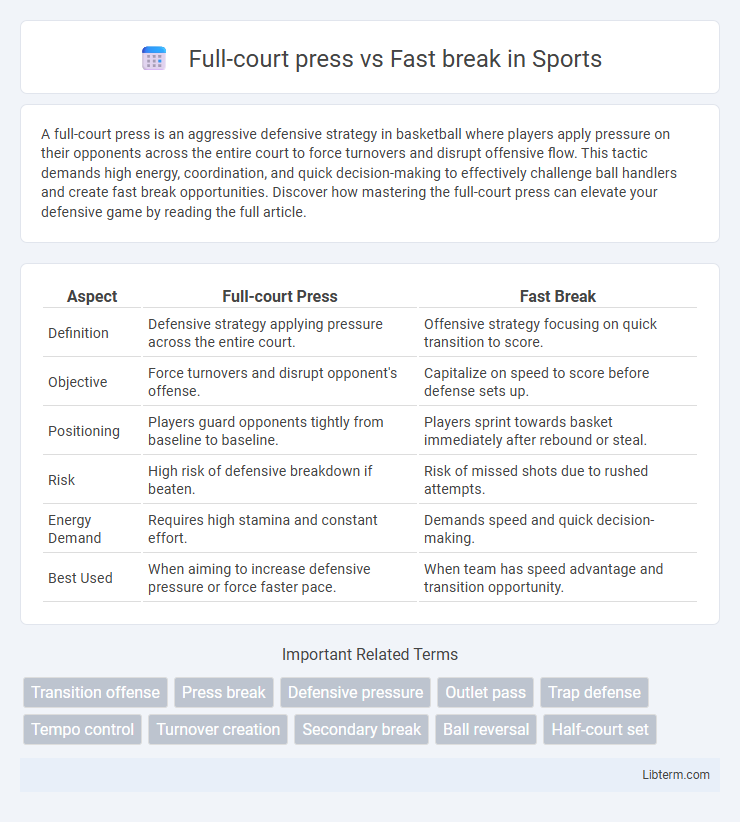A full-court press is an aggressive defensive strategy in basketball where players apply pressure on their opponents across the entire court to force turnovers and disrupt offensive flow. This tactic demands high energy, coordination, and quick decision-making to effectively challenge ball handlers and create fast break opportunities. Discover how mastering the full-court press can elevate your defensive game by reading the full article.
Table of Comparison
| Aspect | Full-court Press | Fast Break |
|---|---|---|
| Definition | Defensive strategy applying pressure across the entire court. | Offensive strategy focusing on quick transition to score. |
| Objective | Force turnovers and disrupt opponent's offense. | Capitalize on speed to score before defense sets up. |
| Positioning | Players guard opponents tightly from baseline to baseline. | Players sprint towards basket immediately after rebound or steal. |
| Risk | High risk of defensive breakdown if beaten. | Risk of missed shots due to rushed attempts. |
| Energy Demand | Requires high stamina and constant effort. | Demands speed and quick decision-making. |
| Best Used | When aiming to increase defensive pressure or force faster pace. | When team has speed advantage and transition opportunity. |
Introduction to Full-Court Press and Fast Break
The full-court press is a defensive basketball strategy that applies pressure on the offensive team across the entire court, aiming to force turnovers and disrupt their play rhythm. In contrast, the fast break is an offensive tactic focused on quickly advancing the ball after a defensive rebound or steal to score before the opposing defense sets up. Both strategies emphasize speed and aggressive play but serve different purposes: the full-court press generates defensive pressure, while the fast break capitalizes on rapid scoring opportunities.
Key Differences Between Full-Court Press and Fast Break
The full-court press is a defensive strategy where the team applies pressure across the entire court to force turnovers, while the fast break is an offensive tactic aimed at quickly advancing the ball to score before the defense sets up. The primary difference lies in their purpose: the full-court press disrupts opponents and creates scoring opportunities through defense, whereas the fast break capitalizes on speed and transition to generate easy baskets. Effective use of the full-court press requires high stamina and coordination, whereas the fast break demands quick decision-making and fast, accurate passing.
Strategic Objectives of Each Tactic
A full-court press aims to disrupt the opposing team's offense by applying constant defensive pressure across the entire court, forcing turnovers and accelerating the game tempo. The strategic objective of a fast break is to capitalize on those turnovers or rebounds by quickly advancing the ball to score before the defense can set up. Both tactics prioritize creating high-pressure situations but differ in their primary focus: the full-court press emphasizes defensive disruption, while the fast break centers on rapid offensive execution.
Advantages of Utilizing a Full-Court Press
Utilizing a full-court press in basketball maximizes defensive pressure, forcing turnovers and disrupting the opponent's offensive rhythm early. This aggressive tactic can create scoring opportunities through fast breaks initiated by quick steals or intercepted passes. Teams employing a full-court press often increase game tempo control, wearing down opponents physically and mentally over time.
Benefits of Executing a Fast Break
Executing a fast break maximizes scoring opportunities by rapidly advancing the ball before the opposing defense can set up, leading to higher-percentage shots and easy baskets. This strategy exploits transitional moments, often resulting in numerical advantages such as 3-on-2 or 2-on-1 situations. Fast breaks also increase overall game tempo, boosting team energy and potentially wearing down opponents defensively.
Defensive Impact: Full-Court Press Explained
The full-court press imposes intense defensive pressure by extending coverage across the entire court, forcing turnovers and disrupting the opposing team's rhythm. This aggressive tactic enhances defensive impact by creating hurried decisions, increasing steals, and limiting effective ball movement. Fast breaks capitalize on defensive stops but rely on transition speed, whereas the full-court press directly influences defense by proactively controlling opponent possessions.
Offensive Edge: Fast Break in Action
Fast break offenses create scoring opportunities by quickly advancing the ball, exploiting defensive gaps before the opposing team can set up. This strategy emphasizes speed, ball control, and quick decision-making to generate high-percentage shots in transition. Effective fast breaks increase points per possession and often result in uncontested layups or open three-pointers, giving teams a significant offensive advantage.
Situational Uses in Competitive Play
A full-court press is most effective when a team aims to disrupt the opponent's ball control and force turnovers early in the game or during crucial moments to shift momentum. Fast breaks capitalize on quick transitions from defense to offense, exploiting defensive lapses to score high-percentage baskets before opponents can set up their defense. Coaches strategically employ full-court presses to increase defensive pressure and fast breaks to maximize scoring opportunities in fast-paced competitive scenarios.
Player Roles and Skills Needed
Full-court press demands players with exceptional endurance, quick decision-making, and aggressive defensive skills to maintain constant pressure on the opposing team. Fast break requires players with superior speed, ball-handling, and passing accuracy to rapidly transition from defense to offense and exploit scoring opportunities. Both strategies rely on cohesive teamwork but emphasize different physical and tactical abilities tailored to defensive intensity versus offensive speed.
Choosing the Right Strategy for Your Team
Selecting between a full-court press and a fast break hinges on your team's defensive and offensive strengths. A full-court press applies constant pressure to disrupt opponent ball handlers and force turnovers, ideal for teams with aggressive defenders and high stamina. In contrast, a fast break emphasizes quick transitions and exploiting open lanes, benefiting squads with speed and effective passing to capitalize on scoring opportunities.
Full-court press Infographic

 libterm.com
libterm.com